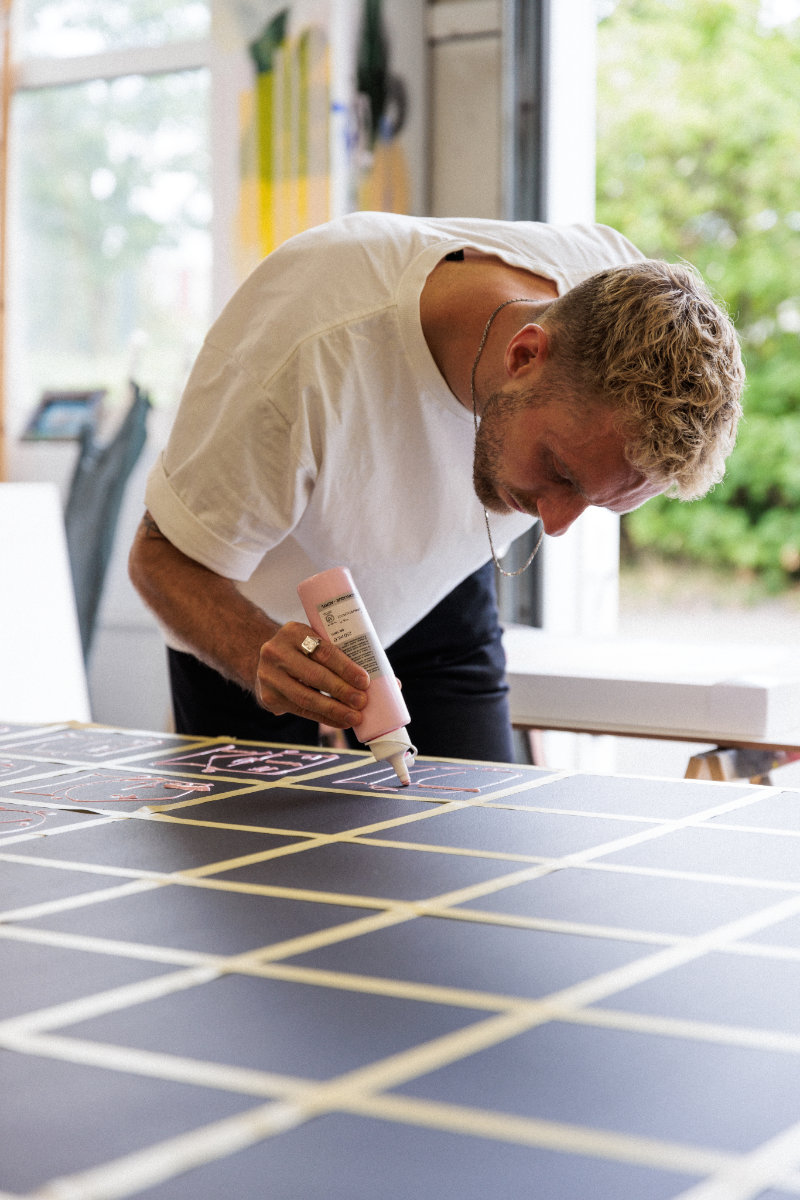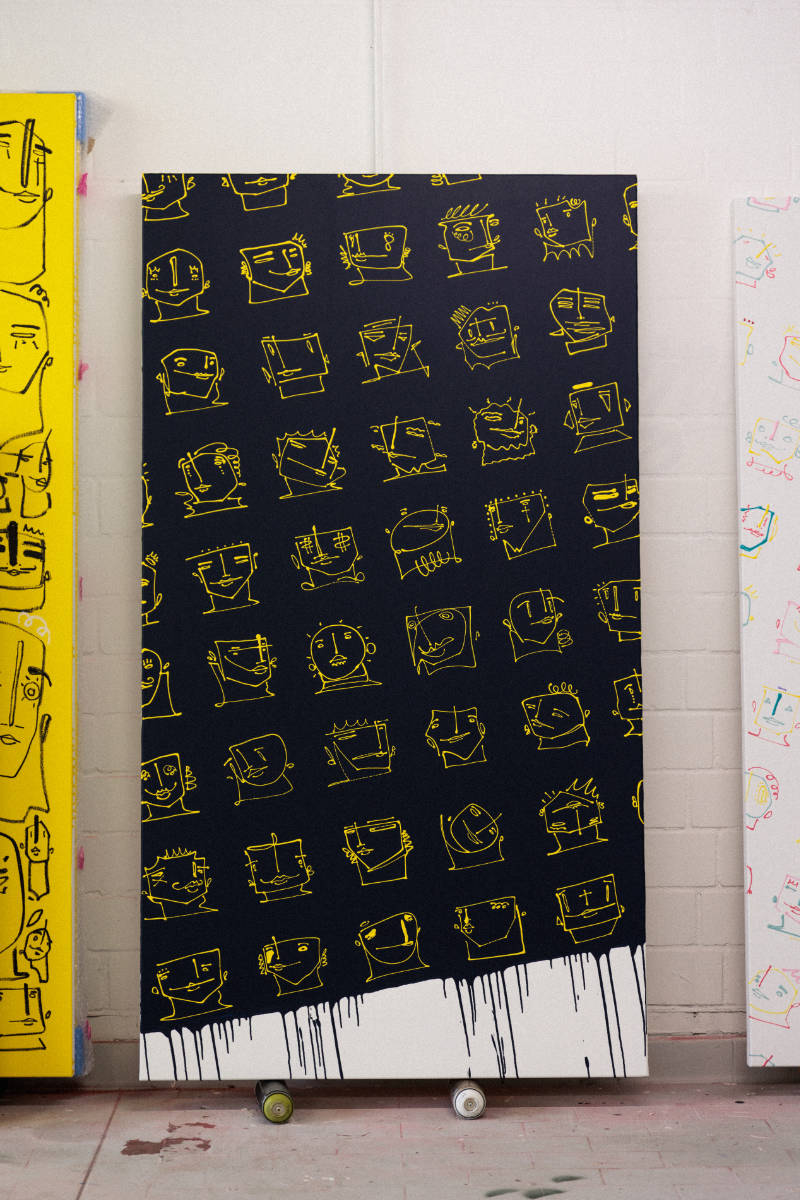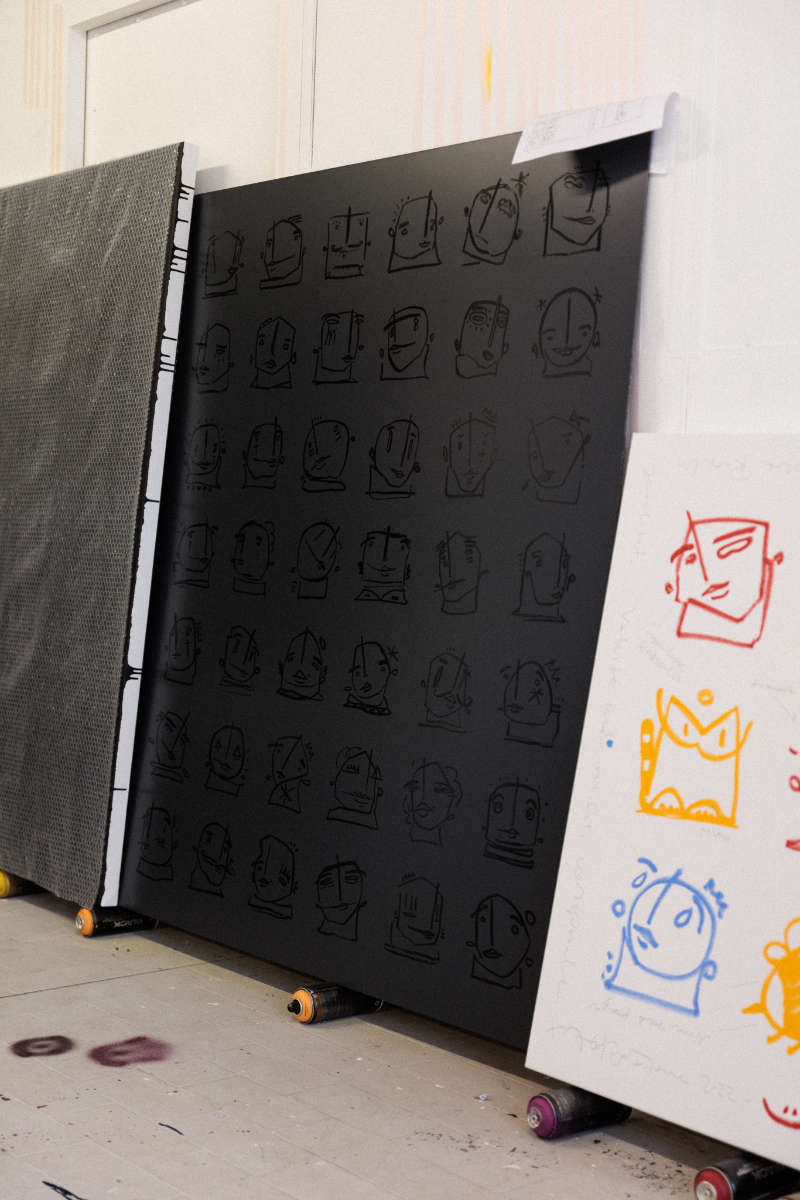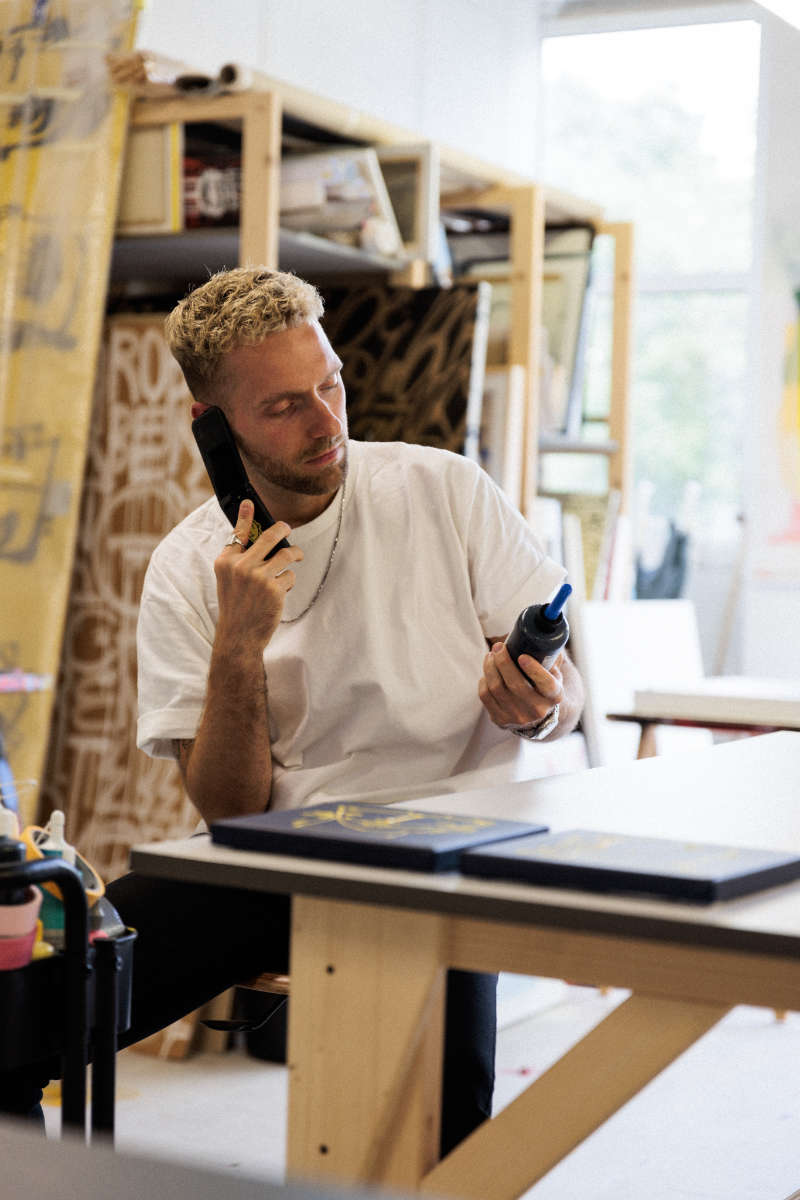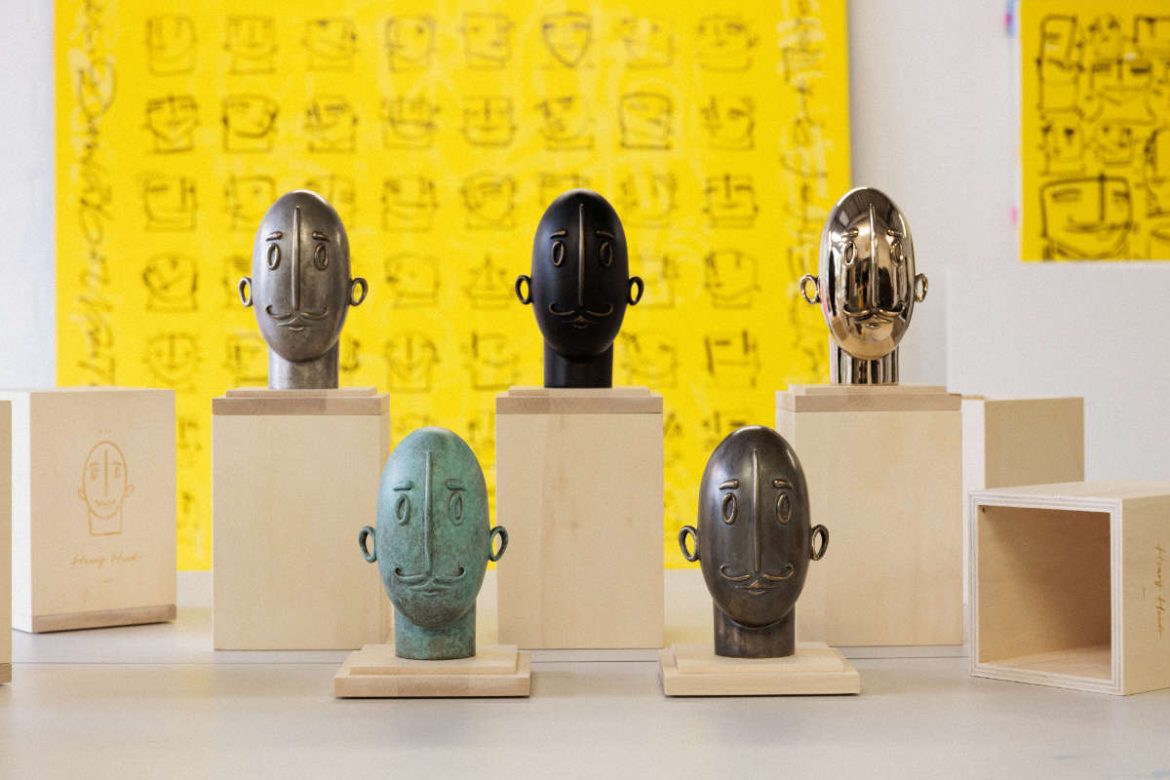Name: Steffen Mumm
Alter: 31
Beruf: freischaffender Künstler und Streuner
Gelernter Beruf: Industriemechatroniker
www.hokerone.de
Instagram @hoker_one
“Ich liebe es Anfänger zu sein.” Steffen Mumm aka Hoker One ist freischaffender Künstler. Seine Arbeiten bewegen sich zwischen Graffiti, Lettering und Illustration. Er lässt die Grenzen miteinander verfließen, mischt sie neu auf und kreiert damit seinen eigenen Kunststil. Bekannt ist er vor allem für seine “Heads”, die durch seine Faszination an den Menschen entstanden sind und ein gesellschaftskritischer Anstupser in Sachen menschliches Miteinander sein sollen. Obwohl er seit 20 Jahren künstlerisch aktiv ist, sucht er immer neue kreative Herausforderungen, denen er sich stellen kann. Was es mit dem Anfängersein auf sich hat, welches Gebiet er gerade neu entdeckt und was für ihn ehrliche Kunst ist, erzählt er im THE DORF-Interview. Challenge accepted!
>>Please scroll down for English version!<<
Wie würdest Du Deinen künstlerischen Ansatz beschreiben? Ich mische sehr viel. Meine Wurzeln sind die Sprühdose und Graffiti Styles, aber irgendwann habe ich Interesse für die Kalligraphie entwickelt und später kamen Lettering und Illustration dazu. So sind auch die Kopfmotive (Heads) entstanden. Mein künstlerischer Ansatz ist intuitiv und sprunghaft.
Gab es einen bestimmten Moment in Deinem Leben, der Deine Leidenschaft für Graffiti und Kalligraphie geweckt hat? Ja, es gab ein paar Schlüsselmomente in meiner Kindheit. Meine Grundschule wurde von Neusser Graffiti-Künstlern gestaltet. Ich stand als 7-jähriger Junge davor und war total begeistert. Der Künstler hatte Kindheitshelden und einen 3D-Schriftzug gemalt. Ein weiterer Moment war in der 5. oder 6. Klasse. Ich habe ein Schulbuch bekommen, in dem eine kleine Graffiti-Skizze lag. Diese Skizze habe ich immer nachgemalt. Also mit 11 Jahren ging’s los.
Kalligraphie ist die Kunst des schönen Schreibens. Du kreierst mit ihr abstrakte Kunstwerke. Wie bist Du darauf gekommen? Mir wird schnell langweilig. 2013 habe ich ein Kalligraphie-Set bei meinen Eltern gefunden und mich von den Graffiti-Styles gelöst. Ich habe sehr gerne Graffiti-Tags, also diese Schriftzüge, die man überall an den Mauern sieht, gemacht und mit Kalligraphie anzufangen, war dann naheliegend. Das ist ja auch eine Art des Schreibens und trotzdem etwas Neues. Ich mag es, neue Dinge auszuprobieren. Immer wieder Anfänger zu sein.
Graffiti stammt ursprünglich aus der Hiphop-Bewegung des New Yorks der 1970er. Wie stehst Du zum Hiphop? Hiphop inspiriert mich total! In der Schulzeit habe ich einen Kumpel gehabt, der immer die Underground-Musik aus der Plattensammlung seines großen Bruders mitgebracht hat. Während alle anderen Deutschrap gehört haben, waren wir eher auf der amerikanischen Seite und haben alles, was überwiegend aus den Staaten kam, gehört. Wir waren wie in einem Film: Kopfhörer auf, Bahn fahren, Graffiti sehen und dabei Underground Rap hören. Das hat mich sehr geprägt und begleitet mich immer noch.
Neben der Spraydose und der Ziehfeder ist die Keramik Dein neues Werkzeug. Du bringst demnächst Deinen eigenen Hokerhead als Skulptur heraus. Was hat es damit auf sich? Ich habe immer Lust, etwas Neues zu machen und zu wachsen. Ich sprühe jetzt seit 20 Jahren und bin so routiniert geworden – fast schon wie ein Roboter. Keramik bremst mich aus. Ich kenne das Material nicht. Es muss erst einmal trocknen, dann verändert es sich, vielleicht hält etwas nicht oder verändert sich ein zweites Mal. Es ist sehr spannend und macht Spaß. Ich bin wie ein Kind: Immer wieder hinfallen und aufstehen. Irgendwann kann ich bestimmt auch laufen. Der Hokerhead ist allerdings eine Bronzeskulptur. Die Grundlage ist ein Sketch. Aus dem Sketch wurde ein digitales 3D Modell erstellt, 3D gedruckt und von diesem Modell wurde dann eine Form für den Bronzeguss erstellt.
Charakteristisch für Deine Kunst sind vor allem Köpfe. Was möchtest Du damit ausdrücken? Die Köpfe sind ein Beiprodukt meiner Entwicklung. In Zeichenkursen habe ich bemerkt, dass ich unglaublich gern Gesichter zeichne und das habe ich dann bei den Graffiti Styles und der Kalligraphie realisiert. Ich war und bin ein beobachtender Mensch. Mich fasziniert, wie Menschen sind, wie wir miteinander kommunizieren und leben. Das spiegelt sich in den Arbeiten wider. Die Menschen vergleichen sich heutzutage viel zu viel und schauen nur nach links, rechts, oben und unten. Dadurch werten wir uns mitunter auch selbst ab, anstatt in unserer Mitte zu bleiben. Dieses Phänomen wird in meiner Compare-Reihe thematisiert. Aber am Ende soll meine Kunst die Menschen einfach begeistern und anziehen. Wenn sie die Gesichter auf der Leinwand sehen, ist es toll zu beobachten, wie manche sich ihren Charakter herauspicken und sich daran erfreuen.
Du hast außerdem das Weinetikett einer Edition des Düsseldorfer Sommeliers asktoni gestaltet. Wie wichtig ist Dir der Austausch mit Locals und anderen Kreativen? Sehr wichtig, da ich kein Teil eines Künstler*innenkollektivs bin und alleine arbeite. Das will ich eigentlich nicht. Ich bin in meinem Atelier in meinem Kokon. Als introvertierter Typ komme ich gut klar damit, nicht die ganze Zeit von Menschen umgeben zu sein, aber es macht auch viel Spaß mit anderen zusammenzuarbeiten, vor allem wenn wir harmonieren. Das war zum Beispiel bei Toni der Fall. Sein Herz schlägt auch für Hiphop und wir mögen beide hochwertige, schöne Dinge. Das war ein perfect Match! Hier geht’s zur Edition…
Was inspiriert Dich? Meine Hauptinspiration ist die Praxis an sich, aber auch Farben aus der Natur. Im Sommer war ich in Kopenhagen, wo alles moosgrün war. Das hat mich inspiriert und ich plane jetzt eine dunkelgrüne Leinwand. Ich sauge vieles wie ein Trichter auf, aber ich glaube am Ende entstehen die Ideen immer während des Malens. Ein Beispiel dafür sind die Gesichter. Bei meinen alten Graffiti-Styles und vor allem den typografischen “Malereien” ging und geht es sehr viel um Proportionen und Linien, die immer sehr genau und chirurgisch gezeichnet sind. Die Köpfe sind das Gegenstück dazu. Da arbeite ich eher, wie beim Graffiti-Tagen. Die Arbeiten sind nicht vorgezeichnet und ich korrigiere nichts. Das ist freier, ehrlicher und besitzt mehr Ausdruck. Trotzdem sind die Köpfe eher geschrieben und weniger gemalt, da ich schnelle Linien mache. Wie eben ein Graffiti-Tag.
Was sind Deine Lieblingsorte in Düsseldorf? Das neue Café “Bar Janots” in Flingern gefällt mir gut. Gerade Flingern als kleiner Kiez mag ich gern. Es gibt viele schöne Orte in Düsseldorf. Ich bin auch gerne in Friedrichstadt und am Rhein im Three Little Birds.
Düsseldorf als Graffitimauer, wie würde das aussehen? Kontrastreich. Gerade Düsseldorf ist typisch für einen Spagat zwischen Graffitiszene und Kunstwelt. Dort befinde ich mich auch. Diese beiden Welten sehe ich in Düsseldorf – Kunst und das Urbane auf den Straßen.
Was bringt die Zukunft? Mal sehen, auf jeden Fall Veränderung 🙂
Vielen Dank!
Text: Franka Büddicker
Fotos: KESTER
© THE DORF 2022
English version:
Name: Steffen Mumm
Age: 31
Profession: artist
Professional education: industrial mechatronics technician
www.hokerone.de
Instagram @hoker_one
“I love being a beginner.” Steffen Mumm aka Hoker One is a freelance artist. His work moves between graffiti, lettering and illustration. He lets the boundaries flow together, mixes them up anew and thus creates his own style of art. He is best known for his “Heads”, which are the result of his fascination with people and are intended as a socially critical comment on human interaction. Although he has been artistically active for 20 years, he is always looking for new creative challenges to take on. In THE DORF interview he tells us what being a beginner is all about, which area he is currently rediscovering and what honest art is for him. Challenge accepted!
How would you describe your artistic approach? I mix a lot. My roots are spray can and graffiti styles, but at some point I developed an interest in calligraphy and later I added lettering and illustration. This is also how the head motifs (Heads) came about. My artistic approach is intuitive and erratic.
Was there a particular moment in your life that sparked your passion for graffiti and calligraphy? Yes, there were a few key moments in my childhood. My primary school was decorated by graffiti artists from Neuss. I stood in front of it as a 7-year-old boy and was totally inspired. The artist had painted childhood heroes and a 3D lettering. Another moment was in the 5th or 6th grade. I got a school book that had a little graffiti sketch in it. I always copied this sketch. So at the age of 11, it started.
Calligraphy is the art of beautiful writing. You create abstract works of art with it. How did you get into it? I get bored quickly. In 2013, I found a calligraphy set at my parents’ house and and artistically moved away from. I really liked doing graffiti tags, those letterings you see all over the walls, and starting calligraphy was then obvious. It’s also a kind of writing and yet something new. I like trying out new things. To be a beginner again and again.
Graffiti originally comes from the hip hop movement in New York in the 1970s. How do you feel about hip hop? Hip hop totally inspires me! When I was at school, I had a buddy who always brought the underground music from his big brother’s record collection. While everyone else listened to German rap, we were more on the American side and listened to everything that came mostly from the States. We were like in a film: headphones on, riding the train, seeing graffiti and listening to underground rap. That had a big impact on me and is still with me.
Besides the spray can and the drawing pen, ceramics are your new tool. You will soon be releasing your own Hokerhead as a sculpture. What is it all about? I always feel like making something new and growing. I’ve been spraying for 20 years now and have become so routine – almost like a robot. Ceramics slow me down. I don’t know the material. It has to dry first, then it changes, maybe something doesn’t hold or changes a second time. It’s very exciting and fun. I’m like a child: always falling down and getting up. I’m sure I’ll be able to walk one day. The Hokerhead, however, is a bronze sculpture. The basis is a sketch. From the sketch, a digital 3D model was created, 3D printed and from this model a mould was then created for the bronze casting.
Heads are characteristic of your art. What do you want to express with them? The heads are a by-product of my development. In drawing classes, I noticed that I really like to draw faces and then I realised this in the graffiti styles and calligraphy. I was and am an observant person. I am fascinated by how people are, how we communicate and live with each other. This is reflected in the works. Nowadays, people compare themselves far too much and only look left, right, up and down. As a result, we sometimes devalue ourselves instead of staying in our centre. This phenomenon is addressed in my Compare series. But in the end, my art should simply inspire and attract people. When they see the faces on the canvas, it’s great to see how some pick out their character and enjoy it.
You also designed the wine label for an edition of the Düsseldorf sommelier Toni Askitis (asktoni). How important is the exchange with locals and other creatives to you? Very important, because I’m not part of a collective of artists and work alone. I don’t really want that. I am in my cocoon in my studio. As an introvert, I’m fine with not being surrounded by people all the time, but it’s also a lot of fun to work with others, especially when we harmonise. That was the case with Toni, for example. His heart also beats for hip hop and we both like high-quality, beautiful things. It was a perfect match! Click here for the edition…
What inspires you? My main inspiration is the practice itself, but also colours from nature. In the summer, I was in Copenhagen where everything was moss green. That inspired me and I am planning a dark green canvas. I soak up a lot of things like a funnel, but I think in the end the ideas always come while painting. An example of this is the faces. My old graffiti styles and especially the typographic “paintings” were and are very much about proportions and lines, which are always drawn very precisely and surgically. The heads are the opposite of that. There I work more like when I’m doing graffiti. The works are not pre-drawn and I don’t correct anything. It’s freer, more honest and has more expression. Nevertheless, the heads are more written and less painted, because I make quick lines. Just like a graffiti day.
What are your favourite places in Düsseldorf? I like the new café “Bar Janots” in Flingern. Especially Flingern as a small neighbourhood I like. There are many nice places in Düsseldorf. I also like being in Friedrichstadt and on the Rhine at Three Little Birds beer garden.
Düsseldorf as a graffiti city, what would that look like? Rich in contrast. Düsseldorf is typical of a city that deals with finding a balance between the graffiti scene and the art world. And that is exactly where I see myself, between the two worlds of Düsseldorf – the world of fine and urban art.
What does the future hold? Let’s see, definitely change!
Thank you very much!
THE DORF • THE MAG is part of the #urbanana project by Tourismus NRW







